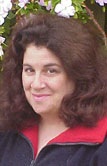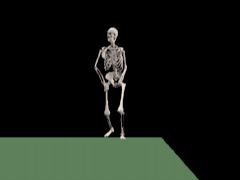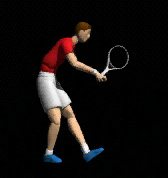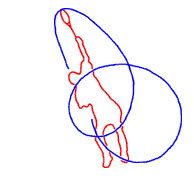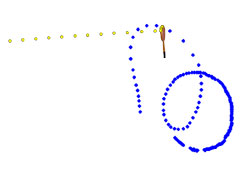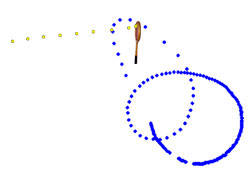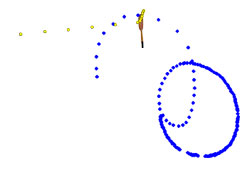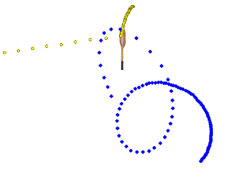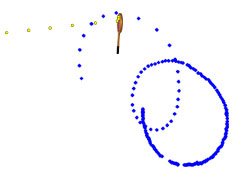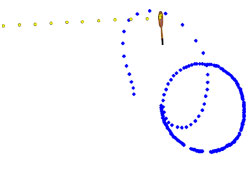September 2003 Article Tennis Server
|

 |
Thanks To Pete Sampras
My family and I were seated in the stands at Arthur Ashe stadium opening day at the US Open. Along with watching the women's and men's evening matches (both Clijsters and Hewitt played) it was a thrill and moving experience to be there for the Pete Sampras' retirement ceremony. What can I add to all the accolades paid to Sampras and his contribution to the game of tennis? I would be repeating everyone else's words: classic, textbook, perfection in motion. However, perhaps I can provide a different perspective from a sport science and technology point of view. John McEnroe may have expressed it best at the ceremony. He commented that Sampras was the hero of half of the players in the locker room while the other half imitated his strokes. Sampras was the one to watch, to learn from AND to analyze. During his professional career significant advances in computer and network technology were made: enhancements in high speed video cameras, digitizing boards, availability of high resolution digital cameras, the Internet, significant increases in computer processor and memory power on your desk and laptops, great strides in the capability and performance of animation and software tools used in biomechanical analysis. Even in 1999 Dr. Duane Knudson, a biomechanist and member of the United States Tennis Association's sport science committee, noted that as the computer technology, software and other tools used to study biomechanics improved, greater contributions could be made. It would simply be easier to conduct studies in the future. Today, there are many more motion capture and analysis tools (both hardware and software) available and not just for elite or professional player studies. There are many inexpensive alternatives to record and analyze your own performance. During an educational project on sport science we conducted which began in 1997, high speed cameras were very expensive. I was quoted over $100,000 for the purchase of one high speed camera (we rented the camera) and about $30,000 for a top of the line analysis system. Now, your digital video camera and a few hundred dollars of software can provide an extremely viable analysis system. Back to Pete Sampras. During these past few years as software and hardware technology changed, Pete Sampras was often the inspiration in our own group to push the limits of analysis. He certainly inspired our skeletal and 3-dimensional computer models of tennis players. (Notice the infamous "toe-tap" on the serve of the 3-D model.) The first racquet-head speed analysis we conducted was based on Sampras' serves - both first and second serves.
Next month we'll return to the discussion of specific hardware and software alternatives available to study tennis biomechanics. As a preview to the next column on biomechanics in tennis, here are the racquet-head and ball patterns from six Pete Sampras serves. There are distinct patterns for the different types of serves. (For a nice review on serves you might want to look at Tennis Server writer Ron Waite's columns on the first serve and second serve.) The blue path is the tip of the racquet-head; the yellow path is the ball. The camera was set up from the sideline near the baseline. These serves were videotaped facing Sampras' left side.
When the analysis was first done, it was easy to note a) the distinct patterns for different types of serves (a flat first serve, a slice or kick second serve) and b) the patterns and racquet-head speed for the same serve type were extremely consistent. You could overlay two flat serve or kick serve patterns and they were almost identical - both the speed of the racquet-head and the pattern the racquet-head made through the air. As we moved onto analyzing other players, armed with Sampras' consistent machine-like results, I initially was surprised that other players (like Venus Williams) did not necessarily have these distinct, consistent, machine-like patterns. Can you pick out the patterns? What type of serve do you think each graphic represents? (Why are there two gaps in some of the graphics? This represents where Sampras' legs were. His legs blocked the camera's view of the racquet-head tip.) Next month, we'll note the type of serve and also place the ball and racquet-head velocities on the diagrams. (The velocity will "give away" the type of serve in some instances, since first serves are typically faster than second serves.) These are typical graphical results from motion analysis software. If you haven't worked in this area before, studying these results can serve as an orientation. Some might think of motion analysis as a cold dehumanizing statistical tool. However, for myself, the harmonious patterns of Sampras' serves brought a sense of beauty to the game and awe of the human body's ability to achieve such repeatable high levels of performance. It was like looking at dance choreography. Several of you who have written me in the past are educators: coaches or classroom teachers. You've told me how this column provides teaching ideas for your players/students. I've had students look at the patterns and asked them to demonstrate to me how a racquet could create this motion. This can be an interesting exercise and gets the students to think and visualize in 3 dimensions. At the US Open a group of fans held a sign up that said, "Thanks For The Memories Pete". Sampras was an inspiration to players, to fans and to sport scientists. He challenged everyone to push their performance limits and for those in sport science this often meant pushing the limits of the motion analysis technology. Enjoy the rest of the US Open (or as Prof. Howard Brody is referring to it the "US Closed Due To Rain".) Let's hope for sunny skies in Flushing Meadows!
Until Next Month ... Jani
This column is copyrighted by Jani Macari Pallis, Ph.D., all rights
reserved.
Dr. Jani Macari Pallis is the founder and CEO of Cislunar Aerospace,
Inc., an engineering and research firm in San Francisco. In addition
to her engineering practice, she has led two collaborations between
NASA and Cislunar, creating educational materials on the aerodynamics
of sports for pre-college students and educators. As the head of
NASA's "Aerodynamics in Sports" project, she has led a team of
researchers investigating the aerodynamics, physics and biomechanics
of tennis. The group has conducted high speed video data capture at
the US Open and research of ball/court interaction, footwork, serve
speeds, trajectories and ball aerodynamics. Pallis received a BS and
MS from the Georgia Institute of Technology, an MS in mechanical
engineering from the University of California, Berkeley and a Ph.D.
in mechanical and aeronautical engineering from the University of
California, Davis. She is a member of the Executive Committee of The
International Sports Engineering Association.
Questions and comments about these columns can be directed to Jani by
using this form.
|



October 2022 Tennis Anyone: Patterns in Doubles by John Mills. September 2022 Tennis Anyone: Short Court by John Mills. |
 You will join 13,000 other subscribers in receiving news of updates to the Tennis Server along with monthly tennis tips from tennis pro Tom Veneziano.
You will join 13,000 other subscribers in receiving news of updates to the Tennis Server along with monthly tennis tips from tennis pro Tom Veneziano. 